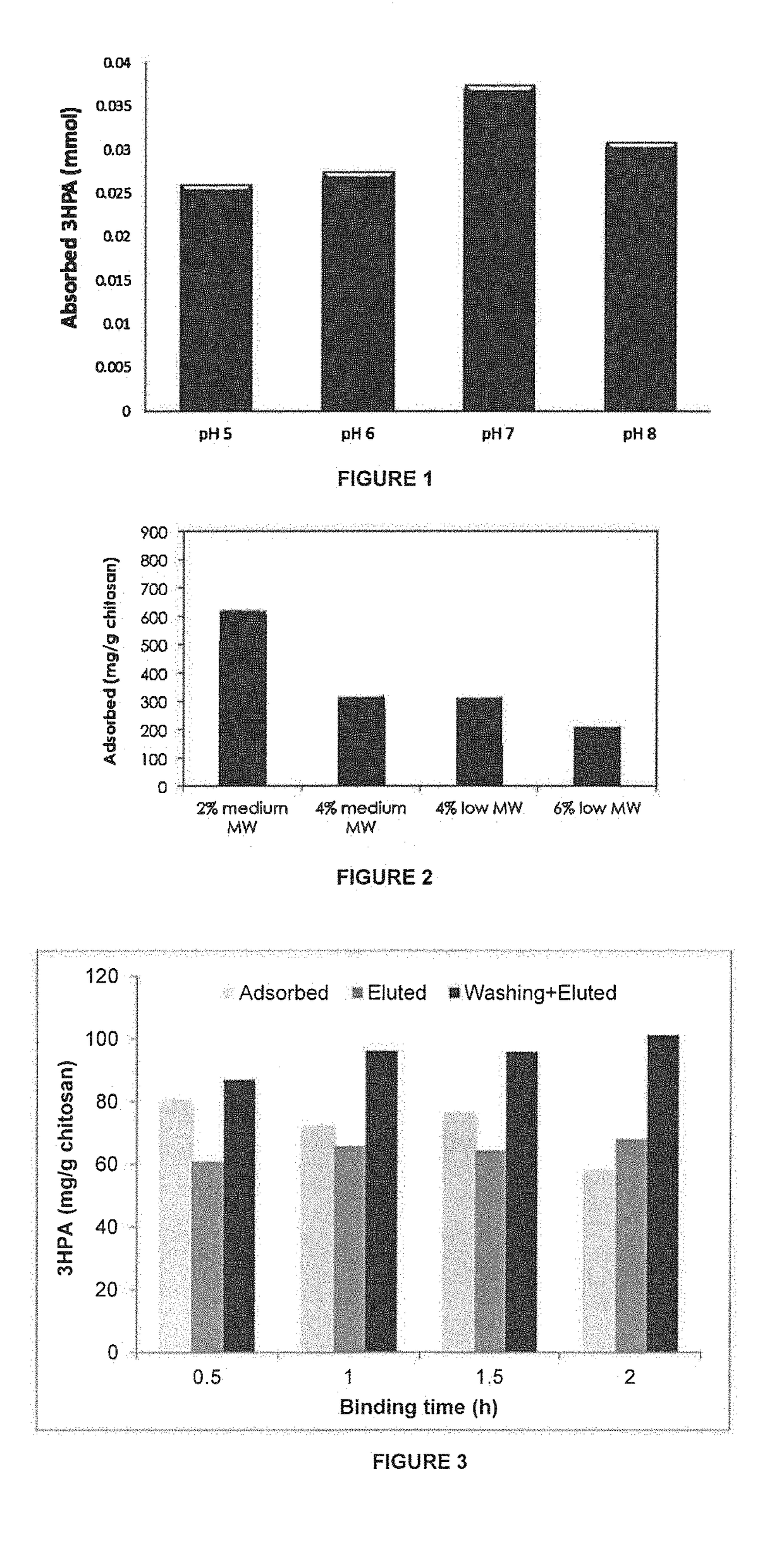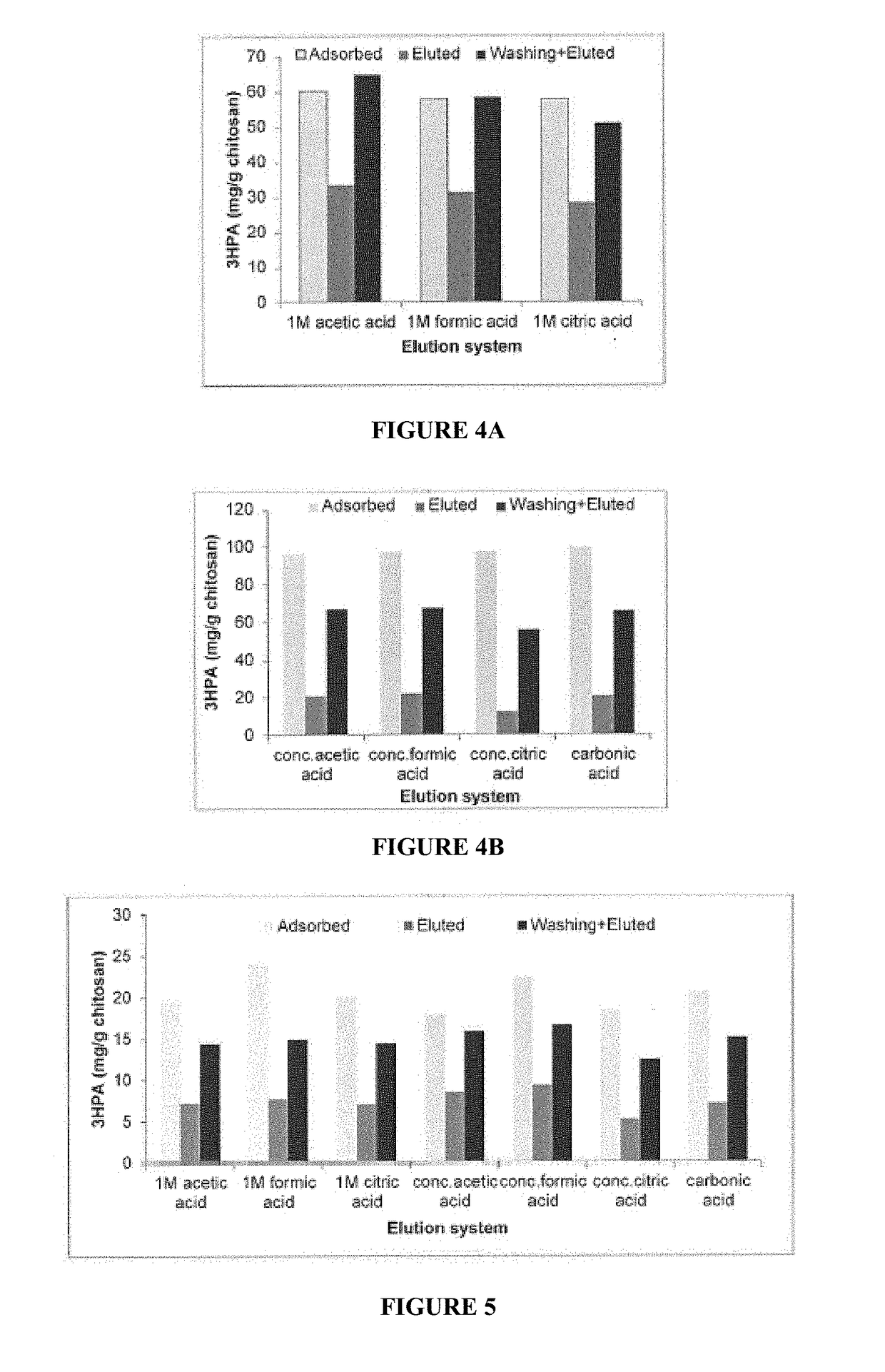3-hydroxypropionaldehyde detection and extraction
a technology of 3hydroxypropionaldehyde and detection and extraction, which is applied in the direction of lyases, enzymology, carbon-oxygen lyases, etc., can solve the problems of low efficiency of cells dying and/or producing 3-hpa, inability to economically produce and extract 3-hpa on a larger scale, and inefficiency and cost-effective methods
- Summary
- Abstract
- Description
- Claims
- Application Information
AI Technical Summary
Benefits of technology
Problems solved by technology
Method used
Image
Examples
example 1
Low and Medium Molecular Weight Chitosan Evaluated as Scavengers for 3-HPA
[0050]Initially 0.1 g chitosan powder (low molecular weight component has a viscosity of 20-300 cP (1 wt. % in 1% acetic add—75 to 85% deacetylation) and the medium molecular weight component has viscosity of 200-800 cP (1 wt. % in 1% acetic acid—75 to 85% deacetylation) as supplied commercially by Sigma) was added to 5 ml of 3-HPA solution (95.6 mM), pH 7. 3-Hydroxypropionaldehyde (3-HPA) was produced using Lactobacillus reuteri as described in Sardari et al. 2013 (Sardari, R. R., et al., Biotechnology and Bioengineering, 2013. 110(4): p. 1243-1248). The mixture was mixed for 30 min at room temperature, 22° C., after which the chitosan was separated by centrifugation at 3000×g for 5 min. The concentration of residual 3-HPA in the supernatant 1 was measured by acrolein test. There was 60.1 mM of 3-HPA when low Mw chitosan was used and 53.1 mM of 3-HPA when medium Mw chitosan was used. The chitosan was then was...
example 2
Effect of pH on Binding Capacity
[0053]The effect of the solution pH on the binding capacity was also investigated using medium molecular weight chitosan as scavenger. Binding capacity was measured using the same method used in Example 1. The results are shown in FIG. 1. pH 7 was found optimum for 3-HPA binding.
example 3
Effect of Chitosan Molecular Weight and Concentration on 3-HPA Binding
[0054]Different concentrations (2%, 4% and 6%, respectively) of low- and medium-molecular weight chitosan were dissolved overnight in 2%, 4% or 6% of acetic acid, respectively. Low molecular weight component has a viscosity of 20-300 cP (1 wt. % in 1% acetic add—75 to 85% deacetylation) and the medium molecular weight component has viscosity of 200-800 cP (1 wt. % in 1% acetic acid—75 to 85% deacetylation) as supplied commercially by Sigma. The resulting viscous solutions were dropped in 2%, 4% and 6% of sodium hydroxide solution, respectively through a thick needle. The resulting beads were washed thoroughly with Milli-Q quality water and then with phosphate buffer (pH 7, 50 mM). One g of swollen beads was then placed in a 15-ml falcon tube and 3-HPA solution (5 ml of 46.6 mM, pH 7) was added to the beads and the tubes were mixed on a rocking table for 12 h. The concentration of residual 3-HPA in the solution was...
PUM
| Property | Measurement | Unit |
|---|---|---|
| viscosity | aaaaa | aaaaa |
| temperature | aaaaa | aaaaa |
| temperature | aaaaa | aaaaa |
Abstract
Description
Claims
Application Information
 Login to View More
Login to View More - R&D
- Intellectual Property
- Life Sciences
- Materials
- Tech Scout
- Unparalleled Data Quality
- Higher Quality Content
- 60% Fewer Hallucinations
Browse by: Latest US Patents, China's latest patents, Technical Efficacy Thesaurus, Application Domain, Technology Topic, Popular Technical Reports.
© 2025 PatSnap. All rights reserved.Legal|Privacy policy|Modern Slavery Act Transparency Statement|Sitemap|About US| Contact US: help@patsnap.com


